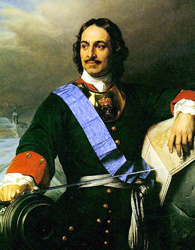Peter the Great became czar of Russia when he was only 10 years old. As a young man, he showed little interest in politics but went on to institute significant reforms during his rule.
Peter’s Early Days
Czar Peter I of Russia was born Peter Alexowitz on May 30, 1672. Even as a young child, Peter enjoyed war games, but he tried to avoid other aspects of politics. He preferred to spend his time pursuing other interests, such as sailing and learning to build ships.
As a young man, Peter spent time abroad in Europe. Bishop Burnet, assigned to attend to Peter during his stay in England, wrote an account of his time with the young czar. “He is mechanically turned, and seems designed by nature rather to be a ship carpenter than a great prince,” he wrote. He also noted that Peter had a bad temper and the tendency to exacerbate his fiery nature by drinking lots of brandy.
Sources in this Story
- Royal Museums Greenwich: Peter the Great
- Fordham University Modern History Sourcebook: Peter the Great and the Rise of Russia, 1682-1725
- The New York Public Library: Russia Engages the World
- BBC 4: In Our Time: The Building of St. Petersburg
- Yale University Library: Coins and Medals of Imperial Russia: Peter I, “the Great” (1689-1725)
- The BBC: Historic Figures: Catherine the Great (1729 – 1796)
Peter the Great’s Notable Accomplishments
After a trip abroad, the czar brought the culture of Western Europe back to Russia, modeling his royal court after those of the west. He ordered noblemen to shave their beards and wear western clothing. He also mandated that women be given the independence to attend social events and encouraged the upper classes to send their sons abroad for schooling.
In 1703, the Russian army seized a Swedish garrison on the Baltic Sea. Peter ordered the construction of a fortress and moved into a small hut as a city was constructed around him. The city, named Saint Petersburg, would become Russia’s new capital and symbolize “a new Russia, one that faced away from the Slavic East and towards the European West,” according to BBC 4’s “In Our Time.”
Czar Peter also completely overhauled Russia’s monetary system. His father had attempted to introduce copper coins, but the people had resisted. To ease them into using the new coins, Peter arranged for simultaneous circulation of silver and copper coins. Photographs of these coins are available on the Yale University Library Web site.
The Rest of the Story
After Peter died in 1725, Russia was in a leaderless, chaotic state for many years. Even his prized city of Saint Petersburg was abandoned when the court he’d established there rushed back to Moscow. His legacy of reform and his efforts to westernize Russia were carried on by Catherine the Great, the wife of Peter’s grandson, Peter III, who was killed in 1762.
This article was originally written by Rachel Balik; it was updated May 6, 2017.











